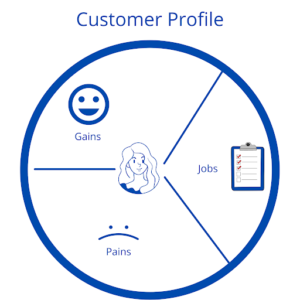Value proposition canvas is a tool that helps you create products or services that solve customers’ needs. The business tool was created by Dr. Alexander Osterwalder—the creator of the business model canvas—for businesses to design products or services that provide value for the market and customers. New and existing products can use the value proposition canvas.
The canvas tool has two building blocks: customer profile and value proposition. Read on to understand how you can create the value proposition canvas.
Part 1: Customer Profile

The first component of the value proposition canvas is the customer profile, usually located on the right side. In the customer profile, you select one customer (something like a buyer persona) representing your audience or a segment of your audience. The element then is separated into three parts:
- Jobs,
- Pains,
- Gains.
Jobs are the functional, social, and emotional tasks the customer is trying to perform along the needs to satisfy. While functional jobs are the practical tasks the customer needs to perform, social jobs are the duties the customer feels she needs to do as part of her role in society or relationship. Emotional jobs are the tasks that respond to customer’s feelings, likes, dislikes, or preferences.
A few questions you can ask to define your customer jobs are:
- What function is your customer most likely to perform?
- What social jobs are they trying to achieve?
- What are their emotional jobs?
- Which one of the jobs makes your customer feel fulfilled?
Pains include all the negative experiences the customer encounters while performing the job. In the pain section, you lay out all the factors that annoy or prevent the customer to finish the tasks you mention earlier.
A few questions you can ask to uncover the customer’s pains are:
- What does your customer think is too expensive?
- What are the main challenges your customer is facing right now?
- What keeps your customer awake at night?
- What features of your products your customer misses?
On the other side, gains include all the positive experiences the customer wishes to achieve after performing the job. They cover everything the customer expects to achieve along those desired or unexpected by the customer.
A few questions you can ask to uncover the customer’s gains are:
- What would your customer prefer to save: time, money, or effort?
- What are your customer expectations, and how can you surpass them?
- What would simplify your customer’s life?
Part 2: The value map

In the second part, you create the value map which focuses on your products or services. Same as the previous section, it includes three parts:
- Products and services
- Pain relievers
- Gain creators
The products and services include all your products, services, and features that you will provide to the customer you described in the first part. The focus for this part is to list all the features that help your customer perform the jobs.
Pain relievers include explanations of how your product or service eases customer pains. The pain relievers should reflect the pains you added to your customer profile.
A few questions you can ask to uncover your pain relievers are:
- Does your product save the customer time, money, or effort?
- How does it remove the risks your customer faces?
- How does your product affect the emotional state of your customer?
- Does your product include features that other products miss?
Gain creators are the last part of the value proposition canvas, in which you include the advantages and positive outcomes your customer gains from your product or service. In this part, you show how your products create values for your customer and how it helps him/her achieve his/her goals.
A few questions you can ask to uncover your gain creators are:
- Does your product ensure the results your customers expect?
- How does your product simplify the life of your customer?
- What are the features that the customer is most looking for in your product?
- How does your customer feel after using your product or service?
The value proposition canvas in action
When you create the value proposition canvas, you will have a clear idea of your customer wants and what you can provide. The next step for you is to rank all the value map items. Based on how they solve your customer problems, you rank the items from nice to have to essential. You reach your value proposition when the product or service you offer solves the most significant gains and pains your customer has.








